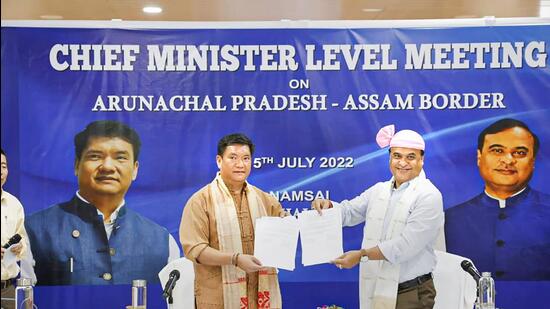Arunachal Pradesh, Assam sign pact to resolve border dispute
Allegations of residents of one state encroaching land on the other have led to disputes and violence. A suit has been pending in the Supreme Court since 1989 on the issue.
Assam and Arunachal Pradesh on Friday signed the Namsai Declaration in a step towards resolving their seven-decade old boundary dispute, chief ministers of both states announced.

The declaration was signed at Namsai in Arunachal Pradesh following the third round of meetings on the issue between chief minister Pema Khandu and his Assam counterpart Himanta Biswa Sarma.
The two states share an 804-km long boundary. Though there was no dispute initially, over the years, allegations of residents of one state encroaching land on the other have led to disputes and violence. A suit has been pending in Supreme Court since 1989 on the issue.
Speaking to reporters after Friday’s meetings, Sarma said: “Earlier, there were 123 border villages that were in dispute. Now, we have agreed to restrict that number to 86 villages. We have also decided to resolve the issue by September 15 this year.”
Both CMs termed the signing a “milestone” and “landmark” that will further strengthen friendship and brotherhood between the two neighbouring northeastern states.
“The border dispute between our states has been ongoing for nearly seven decades now. But it has not seen any progress towards resolution due to lack of political will of earlier governments,” Khandu said.
As per Friday’s declaration, 28 of the 123 disputed villages “which are within the constitutional boundary of Arunachal Pradesh” shall remain with the state.
Conversely, following the withdrawal of claims by Arunachal Pradesh, three villages will remain with Assam.
Finally, 6 more villages, which “couldn’t be located on the Assam side”, will remain with Arunachal Pradesh if they are found to be present on the state's side, the declaration stated.
Sarma and Khandu had met in January and April this year and had agreed to constitute 12 regional committees for joint verification of the disputed areas. The committees were tasked with submitting recommendations to state governments keeping in view “historical perspective, administrative convenience, contiguity and people’s will” to delineate the interstate boundary.
Friday’s declaration agreed that the regional committees will submit their first tranche of reports and a list of areas where consensus has been formed by September 15.
“As and when the regional committees conclude their deliberations and agreement is arrived at between the two governments, the draft MoU will be referred to Government of India for its approval,” the declaration read.
Last year, after meetings with Prime Minister Narendra Modi and Union home minister Amit Shah, both states had resolved to settle their border dispute through out-of-court talks.
The genesis of the border dispute lies in 1873 when the British started the inner-line regulation, creating an imaginary boundary between the plains and hills areas north of Assam. Inner-line regulation, which is still in place, requires people from outside Arunachal Pradesh, to take permits before entering the state.
This area ‘separated’ from Assam was initially called ‘North East Frontier Tracts’. Later the name was changed to North East Frontier Agency (NEFA) and was under the administrative jurisdiction of Assam post-Independence.
In 1972, NEFA was renamed as Arunachal Pradesh and granted the status of a Union Territory (UT). It became a a full-fledged state in 1987.
But before the state got its present boundaries, a committee headed by former Assam chief minister Gopinath Bordoloi transferred around 3,650 sq km of territory, which was earlier with NEFA, to Assam.
Arunachal Pradesh has contested this transfer saying it was done without consulting the people or administration of NEFA.
In March this year, chief ministers of Assam and Meghalaya had inked a deal in New Delhi in presence of Shah to resolve 6 of the 12 points of dispute along their border.
The agreement between Assam and Meghalaya, which favours a ‘give-and-take’ formula, was formulated after both states created several committees comprising ministers, visited the disputed areas and interacted with residents. As per the deal, Assam would get 18.51 sq km of the total 36.8 sq km disputed area while Meghalaya would get 18.29 sq km.
Besides Meghalaya and Arunachal Pradesh, Assam has border disputes with Mizoram and Nagaland, states that were carved out of it.






